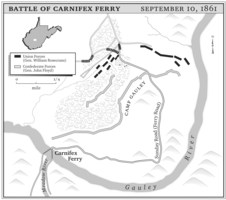 | Back to e-WV
| Back to e-WV
 The West Virginia Encyclopedia
The West Virginia Encyclopedia
 | Back to e-WV
| Back to e-WV
 The West Virginia Encyclopedia
The West Virginia Encyclopedia

In July 1861, Union forces pushed the Confederates out of the Kanawha Valley and occupied the strategic Gauley Bridge area. In August the Confederates launched a counterattack to regain control of the Kanawha Valley and disrupt the attempts to separate Western Virginia from Virginia. Confederate troops under the command of Gen. John Floyd crossed the Gauley River and defeated a small Union force at Keslers Cross Lanes. Floyd then retreated to an encampment along the steep western cliffs of the Gauley River at Carnifex Ferry. Union Gen. William Rosecrans assembled a force of 7,000 to drive the 2,000 Confederates away. Marching south from Summersville, Rosecrans’s force made contact with Floyd on September 10, 1861. Instead of concentrating his force for an overwhelming assault, Rosecrans spent the day sending in his brigades one at a time as they arrived at the battlefield, allowing the outnumbered Confederates to repulse the piecemeal attacks. During the night, the Confederates decided to retreat before they could be defeated in the morning. Floyd managed to get away before Rosecrans knew he was gone.
Casualties were light on both sides, but the battle had an important political effect. Beginning in May 1861, meetings had been held to organize a loyal Unionist government for Virginia to be headquartered at Wheeling. In October, just after the Battle of Carnifex Ferry, there was a vote in areas controlled by federal forces to decide whether to create a new state. The favorable vote was a key step in the formation of West Virginia. A loss at Carnifex Ferry and Confederate occupation of the Kanawha Valley might have changed that vote.
Written by David Bard
Bard, David. Civil War: The New River Valley. Charleston: Quarrier Press, 2004.
Lowry, Terry. September Blood: The Battle of Carnifex Ferry. Charleston: Pictorial Histories Publishing Company, 1985.